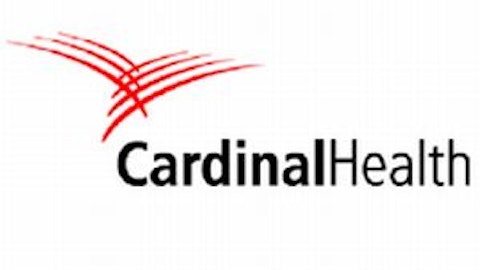Cardinal Health’s Growth Story
Cardinal Health’s management has done an excellent job of positioning the company for future growth through partnerships, acquisitions, and thoughtful international expansion.
At the end of 2013, Cardinal Health and CVS Health (CVS) entered into a sourcing agreement. The company’s created a 50-50 sourcing joint venture called Red Oak Sourcing. Red Oak Sourcing combines the supply chains and purchasing power of both companies to negotiate better deals on generic and pharmaceutical purchases.
Cardinal Health is focusing its international expansion on the Chinese market. The company currently generates around 3% of its sales in China, but plans to grow rapidly in the region both organically and through acquisitions.
The company’s CFO Michael Kaufmann had this to say about Chinese operations in the company’s most recent 4th quarter earnings call:
“Our business in China generated over $3 billion in revenue for the year, resulting in strong double-digit top and bottom line growth. The team there continues to execute well through a combination of organic and inorganic moves and we continue to gain share in our ranking among the top 10 healthcare distributors in China.”
Cardinal Health is forecasting EPS growth of between 7% and 12% next year, with lower revenue growth. About 2 percentage points of growth will come from share repurchases net of share issuances. The bulk of the growth is expected to come from organic growth and margin improvements as the company realizes gains from its Red Oak Sourcing venture.
Cardinal Health made two important acquisitions in 2015:
The bolt-on Harvard Drug acquisition bolsters Cardinal Health’s pharmaceutical segment. Harvard Drug is a generic and over-the-counter health care distributor.
The Cordis acquisition is more interesting. Cordis was owned by Johnson & Johnson (JNJ) – the company is a manufacturer and distributor of cardiology devices and endovascular solutions. The acquisition was done to:
“Expand our Medical segment’s portfolio of self-manufactured products and its geographic scope. Cordis is a global company, with operations in more than 50 countries.”
Cardinal Health’s strong competitive advantage in medical supplies distribution could give it an advantage in selling its own manufactured products. The company’s expansion of its ‘self-manufactured products’ portfolio with the Cordis acquisition hints that Cardinal Health may be focusing on expanding its higher margin manufacturing business, which is complemented by its existing excellent supply chain.
Expected Total Returns for Shareholders
Cardinal Health has compounded its earnings-per-share at 8.1% a year since the 2009 CareFusion spin-off. Dividends have grown at a 16.0% a year clip over the same time period.
Value Line is projecting earnings-per-share growth of 15.0% in fiscal 2016, and compound earnings-per-share growth of 12.5% a year over the next 4 to 5 years.
15% growth next year is certainly possible. Over the long-run, I expect the company to compound its earnings-per-share at 4.5% to 9.5% from the following sources:
- Share repurchases of 1.5% a year
- Sales growth of 2.0% to 5.0% a year
- Margin improvements of 1.0% to 3.0% a year
The company should experience more rapid earnings-per-share growth in the next few years as margins expand quicker than what is sustainable over the long-run.
In addition to 4.5% to 9.5% earnings-per-share growth, Cardinal Health also offers investors a 1.9% dividend yield at current prices.
Including its dividend yield, investors should expect total returns of around 6.5% to 11.5% a year over the long-run from Cardinal Health. Short-term total returns will likely be higher. Click here to see why total return trumps growth and value.
Valuation Is Too Rich At Current Prices
In general, when a company has favorable short-term growth prospects, its price-to-earnings ratio expands.
Cardinal Health Inc (NYSE:CAH) today is no exception. Over the last decade, Cardinal Health’s average price-to-earnings ratio is 16.5. It is currently at 22.7.
Even if Cardinal Health grows its earnings-per-share at 15% a year, it would take more than 2 years for the company’s earnings to ‘catch up’ to its current price-to-earnings ratio (if you believe 16.5 is a fair price-to-earnings ratio for the company).
As a result, I believe Cardinal Health to be overvalued at current prices.
There is nothing wrong with Cardinal Health – it has a strong and especially durable competitive advantage. It is a high quality business with a shareholder friendly management and favorable growth prospects.
The company’s valuation makes now a poor time to start a position in Cardinal Health. The company is currently ranked as a hold using The 8 Rules of Dividend Investing.
While the underlying business is excellent, I believe there are better high quality divided growth stocks to invest in than Cardinal Health at this time.
Disclosure: None



